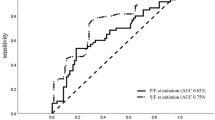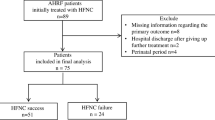Abstract
The primary objective of this study was to evaluate whether pediatric respiratory rate-oxygenation index (p-ROXI) and variation in p-ROXI (p-ROXV) can serve as objective markers in children with high-flow nasal cannula (HFNC) failure. In this prospective, single-center observational study, all patients who received HFNC therapy in the general pediatrics ward, pediatric intensive care unit, and the pediatric emergency department were included. High-flow nasal cannula success was achieved for 116 (88.5%) patients. At 24 h, if both p-ROXI and p-ROXV values were above the cutoff point (≥ 66.7 and ≥ 24.0, respectively), HFNC failure was 1.9% and 40.6% if both were below their values (p < 0.001). At 48 h of HFNC initiation, if both p-ROXI and p-ROXV values were above the cutoff point (≥ 65.1 and ≥ 24.6, respectively), HFNC failure was 0.0%; if both were below these values, HFNC failure was 100% (p < 0.001).
Conclusion: We observed that these parameters can be used as good markers in pediatric clinics to predict the risk of HFNC failure in patients with acute respiratory failure.
What is Known: • Optimal timing for transitions between invasive and noninvasive ventilation strategies is of significant importance. • The complexity of data requires an objective marker that can be evaluated quickly and easily at the patient’s bedside for predicting HFNC failure in children with acute respiratory failure. What is New: • Our data showed that combining p-ROXI and p-ROXV can be successful in predicting HFNC failure at 24 and 48 h of therapy. |
Similar content being viewed by others
Abbreviations
- AUROC:
-
Area under the ROC curve
- HFNC:
-
High-flow nasal cannula
- IMV:
-
Invasive mechanical ventilation
- NIMV:
-
Noninvasive mechanical ventilation
- p-ROXI:
-
Pediatric respiratory rate-oxygenation index
- p-ROXV:
-
Variation in pediatric respiratory rate-oxygenation index
- SpO2 :
-
Pulse oximetry
References
Hough JL, Pham TM, Schibler A (2014) Physiologic effect of high-flow nasal cannula in infants with bronchiolitis. Pediatr Crit Care Med 15:214–219. https://doi.org/10.1097/PCC.0000000000000112
Moreel L, Proesmans M (2020) High flow nasal cannula as respiratory support in treating infant bronchiolitis: a systematic review. Eur J Pediatr 179:711–718. https://doi.org/10.1007/s00431-020-03637-0
Shioji N, Iwasaki T, Kanazawa T, Shimizu K, Suemori T, Sugimoto K, Kuroe Y, Morimatsu H (2017) Physiological impact of high-flow nasal cannula therapy on postextubation acute respiratory failure after pediatric cardiac surgery: a prospective observational study. J Intensive Care 5:35. https://doi.org/10.1186/s40560-017-0226-z
Richter RP, Alten JA, King RW, Gans AD, Rahman AF, Kalra Y, Borasino S (2019) Positive airway pressure versus high-flow nasal cannula for prevention of extubation failure in infants after congenital heart surgery. Pediatr Crit Care Med 20:149–157. https://doi.org/10.1097/PCC.0000000000001783
Colleti Junior J, Azevedo R, Araujo O, Carvalho WB (2020) High-flow nasal cannula as a post-extubation respiratory support strategy in preterm infants: a systematic review and meta-analysis. J Pediatr 96:422–431. https://doi.org/10.1016/j.jped.2019.11.004
Marjanovic N, Flacher A, Drouet L, Le Gouhinec A, Said H, Vigneau JF, Chollet B, Lefebvre S, Sebbane M (2020) High-flow nasal cannula in early emergency department management of acute hypercapnic respiratory failure due to cardiogenic pulmonary edema. Respir Care 65:1241–1249. https://doi.org/10.4187/respcare.07278
Helviz Y, Einav S (2018) A systematic review of the high-flow nasal cannula for adult patients. Critical Care (London, England) 22:71. https://doi.org/10.1186/s13054-018-1990-4
Roca O, Messika J, Caralt B, García-de-Acilu M, Sztrymf B, Ricard JD, Masclans JR (2016) Predicting success of high-flow nasal cannula in pneumonia patients with hypoxemic respiratory failure: the utility of the ROX index. J Crit Care 35:200–205. https://doi.org/10.1016/j.jcrc.2016.05.022
Roca O, Caralt B, Messika J, Samper M, Sztrymf B, Hernández G, García-de-Acilu M, Frat JP, Masclans JR, Ricard JD (2019) An index combining respiratory rate and oxygenation to predict outcome of nasal high-flow therapy. Am J Respir Crit Care Med 199:1368–1376. https://doi.org/10.1164/rccm.201803-0589OC
Sepanski RJ, Godambe SA, Zaritsky AL (2018) Pediatric vital sign distribution derived from a multi-centered emergency department database. Front Pediatr 6:66. https://doi.org/10.3389/fped.2018.00066
Vásquez-Hoyos P, Jiménez-Chaves A, Tovar-Velásquez M, Albor-Ortega R, Palencia M, Redondo-Pastrana D, Díaz P, Roa-Giraldo JD (2019) Factors associated to high-flow nasal cannula treatment failure in pediatric patients with respiratory failure in two pediatric intensive care units at high altitude. Factores asociados al fracaso de la terapia con cánulas nasales de alto flujo en pacientes pediátricos con insuficiencia respiratoria en dos unidades de cuidados críticos pediátricos a gran altitud. Medicina intensiva. https://doi.org/10.1016/j.medin.2019.10.005
Milési C, Essouri S, Pouyau R, Liet JM, Afanetti M, Portefaix A, Baleine J, Durand S, Combes C, Douillard A et al (2017) High flow nasal cannula (HFNC) versus nasal continuous positive airway pressure (nCPAP) for the initial respiratory management of acute viral bronchiolitis in young infants: a multicenter randomized controlled trial (TRAMONTANE study). Intensive Care Med 43:209–216. https://doi.org/10.1007/s00134-016-4617-8
Lee WY, Choi EK, Shin J, Lee EH, Choi BM, Hong YS (2020) Risk factors for treatment failure of heated humidified high-flow nasal cannula as an initial respiratory support in newborn infants with respiratory distress. Pediatr Neonatol 61:174–179. https://doi.org/10.1016/j.pedneo.2019.09.004
Betters KA, Gillespie SE, Miller J, Kotzbauer D, Hebbar KB (2017) High flow nasal cannula use outside of the ICU; factors associated with failure. Pediatr Pulmonol 52:806–812. https://doi.org/10.1002/ppul.23626
Liu J, Li DY, Liu ZQ, Lu GY, Li XQ, Qiao LN (2019) High-risk factors for early failure of high-flow nasal cannula oxygen therapy in children. Zhongguo dang dai er ke za zhi = Chinese J Contemp Pediatr 21:650–655
Guillot C, Le Reun C, Behal H, Labreuche J, Recher M, Duhamel A, Leteurtre S (2018) First-line treatment using high-flow nasal cannula for children with severe bronchiolitis: applicability and risk factors for failure. Arch de Pediatr 25:213–218. https://doi.org/10.1016/j.arcped.2018.01.003
Karim H, Esquinas AM (2019) Success or failure of high-flow nasal oxygen therapy: the ROX index is good, but a modified ROX index may be better. Am J Respir Crit Care Med 200:116–117. https://doi.org/10.1164/rccm.201902-0419LE
Mauri T, Alban L, Turrini C, Cambiaghi B, Carlesso E, Taccone P, Bottino N, Lissoni A, Spadaro S, Volta CA, Gattinoni L, Pesenti A, Grasselli G (2017) Optimum support by high-flow nasal cannula in acute hypoxemic respiratory failure: effects of increasing flow rates. Intensive Care Med 43:1453–1463. https://doi.org/10.1007/s00134-017-4890-1
Mauri T, Carlesso E, Spinelli E, Turrini C, Corte FD, Russo R, Ricard JD, Pesenti A, Roca O, Grasselli G (2019) Increasing support by nasal high flow acutely modifies the ROX index in hypoxemic patients: a physiologic study. J Crit Care 53:183–185. https://doi.org/10.1016/j.jcrc.2019.06.020
Mauri T, Galazzi A, Binda F, Masciopinto L, Corcione N, Carlesso E, Lazzeri M, Spinelli E, Tubiolo D, Volta CA et al (2018) Impact of flow and temperature on patient comfort during respiratory support by high-flow nasal cannula. Critical Care (London, England) 22:120. https://doi.org/10.1186/s13054-018-2039-4
Author information
Authors and Affiliations
Contributions
DY conceived and designed the study and critically reviewed the manuscript.
AY collected and analyzed the data and wrote the first draft of the manuscript.
GI collected the data and wrote a part of the first draft of the manuscript.
OOH acquired the data and critically reviewed the manuscript.
FE acquired the data and critically reviewed the manuscript.
Corresponding author
Ethics declarations
Conflict of interest
The authors declare that they have no conflict of interest.
Ethical approval
This study was performed in line with the principles of the Declaration of Helsinki. Approval was granted by the Çukurova University Faculty of Medicine Non-Interventional Clinical Research Ethics Committee.
Informed consent
Informed consent was obtained from legal guardians.
Additional information
Communicated by Peter de Winter
Publisher’s note
Springer Nature remains neutral with regard to jurisdictional claims in published maps and institutional affiliations.
Communicated by Peter de Winter
Rights and permissions
About this article
Cite this article
Yildizdas, D., Yontem, A., Iplik, G. et al. Predicting nasal high-flow therapy failure by pediatric respiratory rate-oxygenation index and pediatric respiratory rate-oxygenation index variation in children. Eur J Pediatr 180, 1099–1106 (2021). https://doi.org/10.1007/s00431-020-03847-6
Received:
Revised:
Accepted:
Published:
Issue Date:
DOI: https://doi.org/10.1007/s00431-020-03847-6




